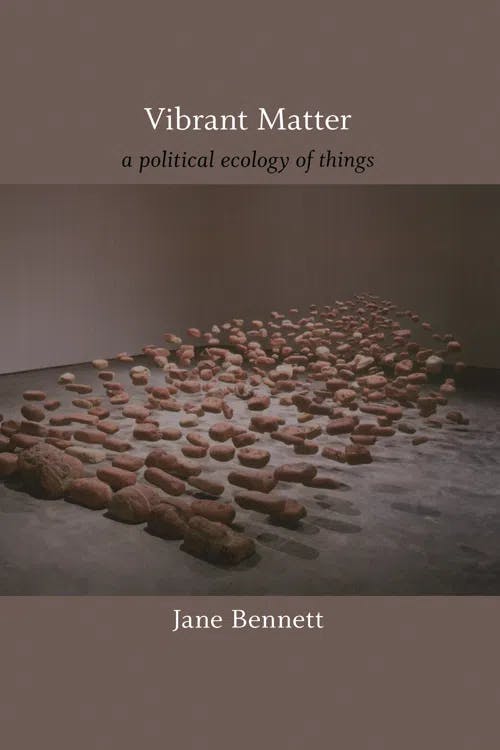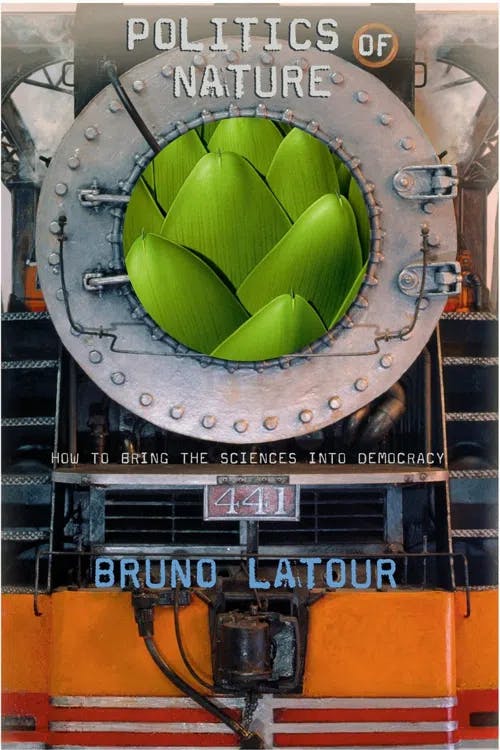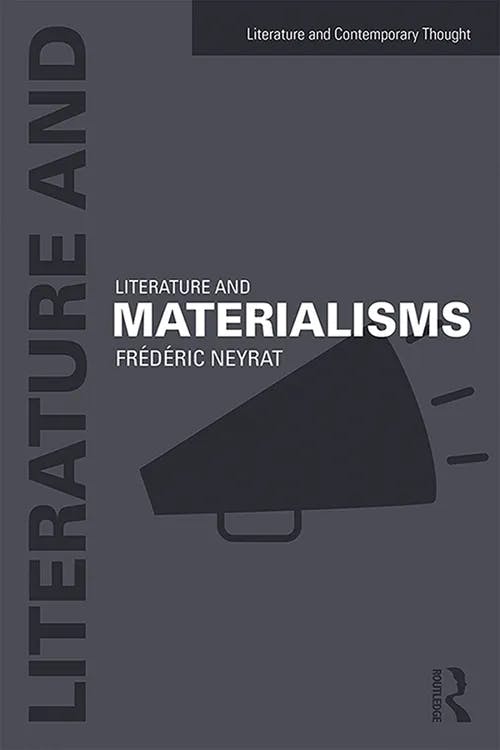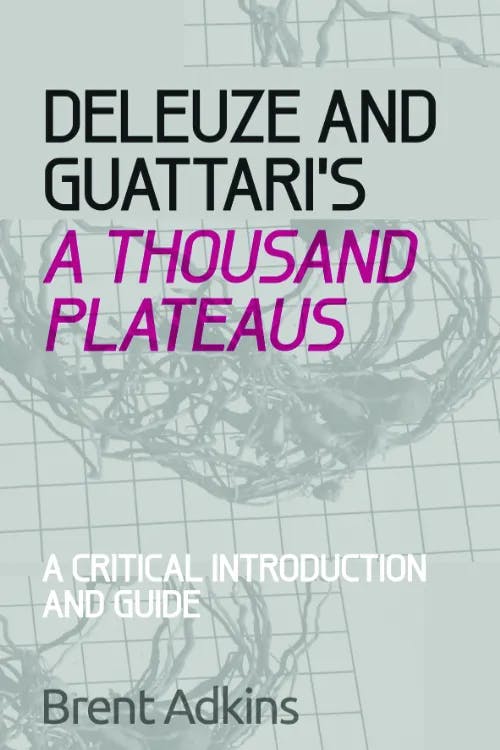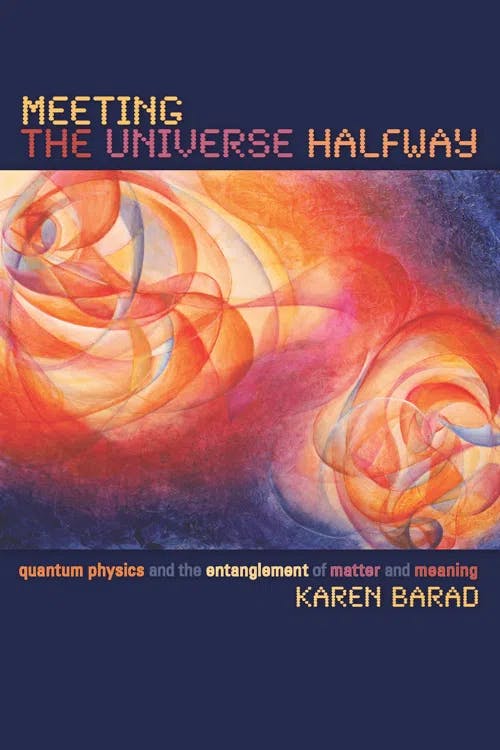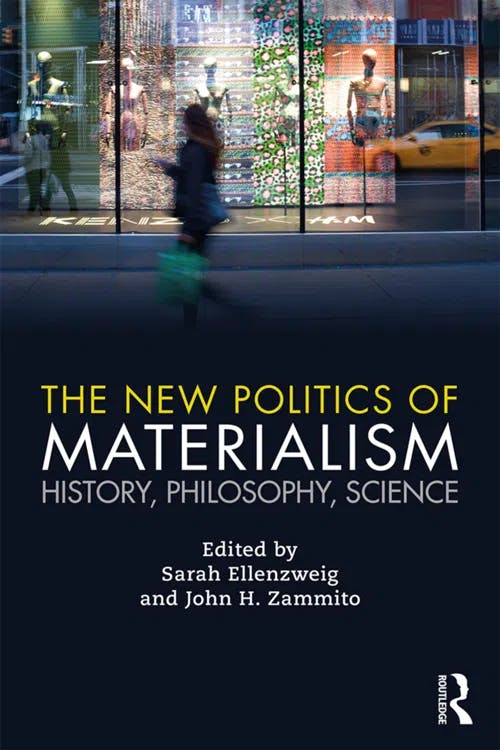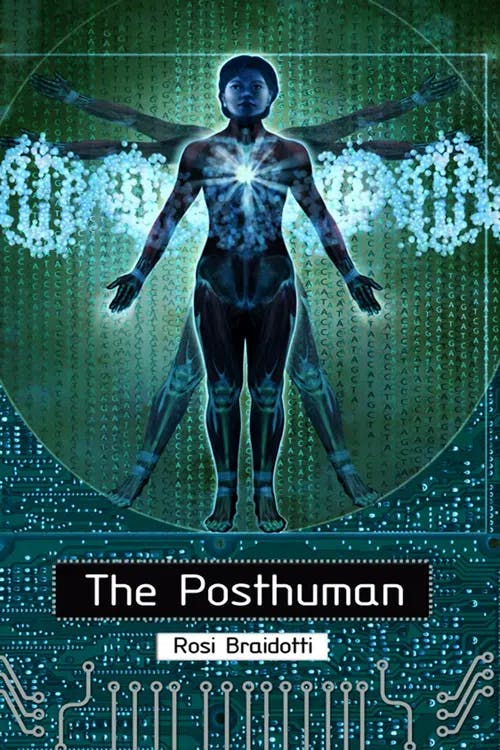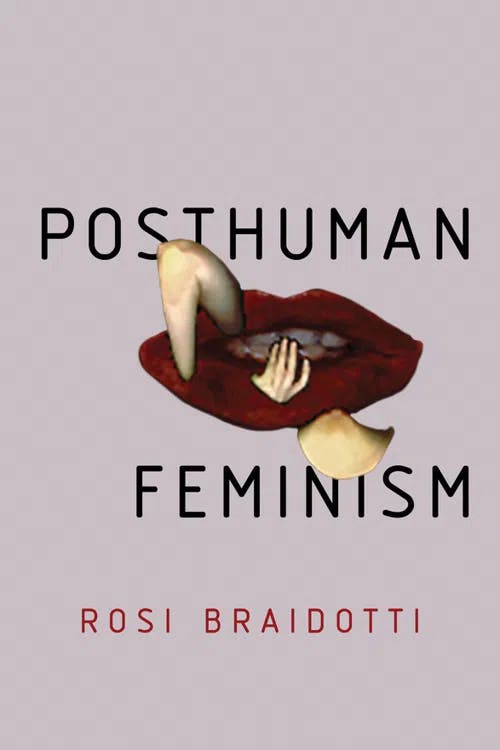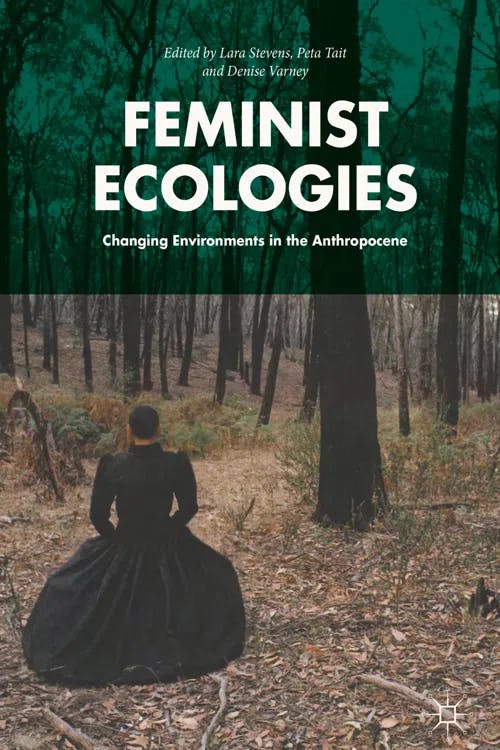What is New Materialism?
MSt, Women's, Gender & Sexuality Studies (University of Oxford)
Date Published: 17.05.2023,
Last Updated: 03.08.2023
Share this article
Defining new materialism
New materialism, or neo-materialism, is an interdisciplinary approach to theory and research that aims to recognize and explore the power of matter. It first emerged in the late 1990s and early 2000s in the works of Rosi Braidotti and Manuel DeLanda.
New materialism builds on materialism, the philosophy that everything is reducible to or dependent upon matter and physical processes. For materialists, everything — from bones to birds to backpacks to brain functions — comes from matter.
We may imagine matter as inert, static, lifeless. But for new materialists, matter is anything but impotent. Matter has force and agency. Jane Bennett calls this “thing-power”: “the curious ability of inanimate things to animate, to act, to produce effects dramatic and subtle” (2010). Bennett argues that matter can shape itself and influence matter around it (including humans). Consider the self-determining potential of stem cells, the trillions of microorganisms that inhabit and affect our bodies (our microbiomes), or the interconnectedness of fungal networks. And thing-power isn’t limited to organic matter; inorganic matter — from microplastics to oil spills — is also entangled in new materialist webs of influence.
The impacts of the Covid-19 pandemic and the development of artificial intelligence reveal the power of matter and the nonhuman. By considering the nonhuman’s capabilities, new materialists undermine human exceptionalism and the assumption that only we have agency. Viewing everything as matter, and all matter as powerful, new materialism refuses to treat humans as more than material, separate from and superior to the world around us. Bennett does not “claim that there are no differences between humans and bones, only that there is no necessity to describe these differences in a way that places humans at the ontological center of the hierarchical apex” (2010).
Bennett writes in Vibrant Matter (2010),
One can invoke bacteria colonies in human elbows to show how human subjects are themselves nonhuman, alien, outside, vital materiality. One can note that the human immune system depends on parasitic helminth worms for its proper functioning or cite other instances of our cyborgization to show how human agency is always an assemblage of microbes, animals, plants, metals, chemicals, word-sounds, and the like.
Jane Bennett
One can invoke bacteria colonies in human elbows to show how human subjects are themselves nonhuman, alien, outside, vital materiality. One can note that the human immune system depends on parasitic helminth worms for its proper functioning or cite other instances of our cyborgization to show how human agency is always an assemblage of microbes, animals, plants, metals, chemicals, word-sounds, and the like.
Engaging with these examples is part of what makes new materialism “new”: its willingness to revise the long history of materialist thought in response to scientific discoveries and our contemporary world.
In addition to questioning the human–nonhuman distinction, new materialism troubles our understanding of subjects and objects. If the subject is the actor, and the object is what is acted upon, what happens when the object acts? New materialism is not the only philosophy interested in complex subject–object interactions (see, for example, phenomenology), but it is perhaps in new materialism that the object most actively strikes back.
Bruno Latour, a prolific French philosopher whose ideas influenced new materialism, describes the necessity of reconsidering objects in Politics of Nature (2004):
objects and subjects can never associate with one another; humans and nonhumans can. As soon as we stop taking nonhumans as objects, as soon as we allow them to enter the collective in the form of new entities with uncertain boundaries [...] it is not hard to see that we can grant them the designation of actors.
Bruno Latour
objects and subjects can never associate with one another; humans and nonhumans can. As soon as we stop taking nonhumans as objects, as soon as we allow them to enter the collective in the form of new entities with uncertain boundaries [...] it is not hard to see that we can grant them the designation of actors.
Latour proposes the term “actant” as an alternative to “subject” or “object,” or the anthropomorphic “actor,” defining actants as “acting agents, interveners” (2004).
While Latour does not necessarily call himself a new materialist, and Bennett deems her theories of “vibrant matter” “vital materialism,” their views have become part of a broader field of inquiry driven by scholars invested in matter and its effects.
Key elements of new materialism
So what unites new materialism(s)? In New Materialisms (2010), Diana Coole and Samantha Frost offer three “interrelated but distinct themes or directions in new materialist scholarship” to structure their collection. These themes reveal the key concerns of new materialism:
- The conception of “matter itself as lively or as exhibiting agency” (2010).
- An interest in “biopolitical and bioethical issues concerning the status of life and the human” (2010).
- A critical re-interpretation of political economy and the relationship between the “material details of everyday life and broader geopolitical and socioeconomic structures” (2010).
These themes reveal how new materialism both zooms in to examine matter itself and zooms out to map large webs of influence. Interdisciplinary in its interests and methods, new materialism embraces questions and approaches from biology, chemistry, physics, ethics, politics, economics, international relations, the social sciences, and more.
Influences on new materialism: dualism, Spinoza, Deleuze & Guattari
Combatting dualism
The Enlightenment was important in the development of materialism because it saw the rise of mechanism, the belief that the world functioned like a machine with explainable internal structures. However, the matter of mechanism was largely “uniform, inert” rather than vibrant (Coole and Frost, 2010). René Descartes separated this mechanical realm of the earthly body from the transcendent, spiritual mind.
“Western” philosophy is deeply influenced by this division of body and mind, or Cartesian dualism. Other dualisms mapped onto it — nature–culture, passion–reason, matter–meaning. Twentieth-century philosophers like Jacques Derrida argue that these binaries are actually hierarchies, with one side considered inferior to the other. Historically, for white, European male philosophers, women and racialized “Others” were more “basely” material, more susceptible to bodily urges, while “civilized” men could transcend substance. Some people were considered more human than others.
New materialism views the mind–matter division as not only false but also politically dangerous. As Frédéric Neyrat writes in Literature and Materialisms (2020),
Hatred of matter is a sad passion because it is an affect that leads us to despise the Earth (too dirty), the body (too mortal), animals (too stupid), or objects (less interesting than us, the beautiful and so, so smart human subjects). If materialism is a battle, it is a battle for life, for the environment, for what is despised, discarded, subjugated – like the workers for political thinker Karl Marx, like the colonized for anti-colonial thinker Franz Fanon, like women for feminist thinker Hélène Cixous.
Frédéric Neyrat
Hatred of matter is a sad passion because it is an affect that leads us to despise the Earth (too dirty), the body (too mortal), animals (too stupid), or objects (less interesting than us, the beautiful and so, so smart human subjects). If materialism is a battle, it is a battle for life, for the environment, for what is despised, discarded, subjugated – like the workers for political thinker Karl Marx, like the colonized for anti-colonial thinker Franz Fanon, like women for feminist thinker Hélène Cixous.
New materialism combats these dualisms, arguing that ignoring the material world both weakens our theory and leads to the marginalization and abuse of groups of people, animals, and the environment.
Spinoza: substance, conatus, affective bodies
Baruch Spinoza is a seventeenth-century philosopher whose ideas have informed new materialism. Spinoza argues against Descartes, proposing monism rather than dualism. In his Ethics (1677), available in A Spinoza Reader (2020), Spinoza identifies three basic entities: substance, mode, and attribute. Justin Steinberg and Valtteri Viljanen clarify these points and their relationship to Descartes’s philosophy in Spinoza (2020):
substance is a self-supporting and conceptually independent entity, and modes inhere in and are conceived through their substance. Attribute is defined in a Cartesian fashion, as that which constitutes the essence of a substance; but Spinoza departs from Descartes in asserting that one substance can have many attributes. [...] There is little doubt that monism, the thesis that there is only one substance, is the most radical and important of those conclusions.
Justin Steinberg and Valtteri Viljanen
substance is a self-supporting and conceptually independent entity, and modes inhere in and are conceived through their substance. Attribute is defined in a Cartesian fashion, as that which constitutes the essence of a substance; but Spinoza departs from Descartes in asserting that one substance can have many attributes. [...] There is little doubt that monism, the thesis that there is only one substance, is the most radical and important of those conclusions.
In short, Spinoza believes that everything is made of the same substance, with different attributes, like materialists believe everything is made of matter.
Another important concept from Spinoza’s philosophy upon which new materialism builds is the “conatus” principle: “Each thing, as far as it can by its own power, strives to persevere in its being” (Spinoza, 1677, [2020]). The idea that animate creatures naturally strive to preserve themselves was not a new idea in philosophy. What was radical about Spinoza’s approach was his application of this doctrine to everything, animate and inanimate alike.
Spinoza proposes that all “things are strivers by their very essence or nature”:
finite things – human and nonhuman alike – strive to do more than just prolong their psychophysical existence; they strive to be active, that is, to produce effects that can be conceived through their own essence alone. (Steinberg and Viljanen, 2020)
We can see similarities between Spinoza’s conatus and Bennett’s thing-power, between striving substance and vital matter.
Spinoza also proposed that bodies are constantly shaping and being shaped by their encounters with other bodies and their environment. These relationships are of particular interest to Deleuze, whose interpretations of Spinoza influenced new materialism.
Deleuze & Guattari: rhizome/assemblage
Gilles Deleuze wrote many important philosophical works on metaphysics, difference, and multiplicity. In 1968, Deleuze met psychoanalyst and political activist Félix Guattari, and the pair collaborated on several projects, including A Thousand Plateaus (1980, [1987]). This text is particularly influential for new materialism because of its theory of the rhizome or assemblage.
An assemblage, defined by Brent Adkins, is “the interconnection of wildly diverse things” (2015). Deleuze and Guattari borrow from botany the term rhizome, meaning an interconnected, subterranean root system, inviting us to think about complex, nonhierarchical, and unexpected relationships. Adkins clarifies that A Thousand Plateaus is not focused on answering “what is a rhizome?”:
Rather, the pertinent question is the experimental, pragmatic question, What might a thing be capable of if it were described as a rhizome rather than a tree? Or better, How can I make a rhizome out of this book? [...] How can I make myself a rhizome? (Deleuze and Guattari’s A Thousand Plateaus, 2015)
Brent Adkins
Rather, the pertinent question is the experimental, pragmatic question, What might a thing be capable of if it were described as a rhizome rather than a tree? Or better, How can I make a rhizome out of this book? [...] How can I make myself a rhizome? (Deleuze and Guattari’s A Thousand Plateaus, 2015)
Deleuze and Guattari provide six principles of assemblages, which Adkins summarizes:
- Assemblages are non-hierarchical.
- Assemblages connect heterogenous (wildly diverse) things.
- Subjects and objects are inherently multiple and “neither stable nor distinct,” “constantly entering into and breaking off combinations with other multiplicities” (2015).
- There are no distinct entities or representations of other subjects, only connected multiples.
- Most philosophers “keep reproducing the same image of thought over and over again,” a tendency Deleuze and Guattari call decalcomania (2015).
- They encourage an approach called cartography, the mapping of unexpected connections as a rhizome.
Bennett builds on these ideas to propose her theory of how agency is distributed across the assemblage. This theory of “distributive agency” acknowledges that everything has its own thing-power, or conatus, but that an actant never truly acts alone. For Bennett, the “efficacy or agency” of an actant “always depends on the collaboration, cooperation, or interactive interference of many bodies and forces” (2010). Moreover, there is “also an effectivity proper to the grouping as such: an agency of the assemblage” beyond the sum of its parts (2010).
By seeing actants (including ourselves) as part of these changing, extensive assemblages, through which agency is distributed, new materialists acknowledge how various actants influence each other. Nonhuman things become more powerful actors, humans less autonomous individuals.
Manuel DeLanda’s Assemblage Theory (2016) provides a detailed analysis of how the idea of the assemblage can be applied to economic, linguistic, and military history as well as to metaphysics, science, and mathematics.
Constructivism v. new materialism, and agential realism
New materialism is often presented as a reaction to the “constructivist” or “linguistic” turn in critical theory. In the twentieth century, many philosophers argued that what we consider innate — gender, race, desire, art — is constructed by culture or language.
While construction was emphasized, matter seemed to fall out of focus. Karen Barad captures this feeling in “Posthumanist Performativity” (2003):
The linguistic turn, the semiotic turn, the interpretative turn, the cultural turn: it seems that at every turn lately every “thing”—even materiality—is turned into a matter of language or some other form of cultural representation. [...] [M]atters of “fact” (so to speak) have been replaced with matters of signification (no scare quotes here). Language matters. Discourse matters. Culture matters. There is an important sense in which the only thing that does not seem to matter anymore is matter. (2003)
New materialism calls for a reconsideration of how matter matters, a call sometimes construed as dismissive of, or inimical to, the constructivist turn. In Posthuman Glossary (2018), Iris van der Tuin argues that this response to new materialism is exaggerated and unfounded, resulting in unproductive (and misled) scholarly schisms. Van der Tuin traces new materialism’s origins not to a reactionary response to the linguistic turn, but to an engagement with linguistic theory. Van der Tuin provides the works of Vicki Kirby — Telling Flesh (1997, [2014]) and Quantum Anthropologies (2013) — as an example of new materialist theories built on constructivist ideas.
New materialists do not universally reject constructivist or linguistic theories. Instead, they see meaning and matter as intertwined. Rather than ignoring discursive processes, new materialists largely argue that we must account for how matter and material processes interact with discourse: “‘material’ is always already material‐discursive—that is what it means to matter” (Barad, 2003).
In Meeting the Universe Halfway (2007), Barad theorizes “agential realism,” an “epistemological-ontological-ethical framework” that “takes account of the fact that the forces at work in the materialization of bodies are not only social, and the bodies produced are not all human.” Barad sees the world as composed of intra-acting agencies. Objects and reality emerge from these intra-actions. Barad claims that agential realism
provides an understanding of the role of human and nonhuman, material and discursive, and natural and cultural factors in scientific and other social-material practices, thereby moving such considerations beyond the well-worn debates that pit constructivism against realism, agency against structure, and idealism against materialism. (2007)
Karen Barad
provides an understanding of the role of human and nonhuman, material and discursive, and natural and cultural factors in scientific and other social-material practices, thereby moving such considerations beyond the well-worn debates that pit constructivism against realism, agency against structure, and idealism against materialism. (2007)
New materialism generally believes that by accounting for how matter interacts with discursive processes, we can look beyond human culture and language to encounter our entanglement with nonhuman factors.
Related theories
Posthumanism
The connections between new materialism and posthumanism are strong. Both philosophies advocate for increased attention to the nonhuman world and its entanglements with the human. Sarah Ellenzweig and John H. Zammito identify this shared project in the introduction to The New Politics of Materialism (2017):
For new materialism, theory’s long-standing constructivist enterprise failed to acknowledge the lively productivity of matter itself, and in this way unwittingly continued to privilege the human agent and its self-proclaimed unique characteristics [...]. The impulse behind the new materialism is decidedly posthumanist, deliberately decentering the human into the encompassing dynamics of the world—a critique, as it were, from the outside in.
Edited by Sarah Ellenzweig and John H Zamtmito
For new materialism, theory’s long-standing constructivist enterprise failed to acknowledge the lively productivity of matter itself, and in this way unwittingly continued to privilege the human agent and its self-proclaimed unique characteristics [...]. The impulse behind the new materialism is decidedly posthumanist, deliberately decentering the human into the encompassing dynamics of the world—a critique, as it were, from the outside in.
Posthumanism responds to humanism, a philosophy centered around the power of the human and human reason. This human was the ideal of its Enlightenment-era creators — white, male, able-bodied, “Western.” As key posthumanist Rosi Braidotti writes in The Posthuman (2013),
Not all of us can say, with any degree of certainty, that we have always been human, or that we are only that. Some of us are not even considered fully human now, let alone at previous moments of Western social, political and scientific history. Not if by ‘human’ we mean that creature familiar to us from the Enlightenment and its legacy.
Rosi Braidotti
Not all of us can say, with any degree of certainty, that we have always been human, or that we are only that. Some of us are not even considered fully human now, let alone at previous moments of Western social, political and scientific history. Not if by ‘human’ we mean that creature familiar to us from the Enlightenment and its legacy.
Posthumanism views the human as an unsettled category, always in the process of becoming. It argues that relationships between humans and nonhumans are much more porous than we might think.
Feminist new materialism
Feminist approaches to new materialism and posthumanism orient these theories toward understanding gendered oppression. While many key contributors to new materialism and posthumanism are also scholars of gender and sexuality, new materialism has also sparked a divide in feminist scholarship because of its emphasis on the body. How do we account for bodily experiences of gender and sexuality without falling into biological essentialism? Where does gender as a cultural construct fit in?
Braidotti’s Posthuman Feminism (2021) is just one book which aims to bridge approaches from various philosophical schools, including feminism and cultural studies. She writes,
Feminism is a new materialism in that it mobilizes the knowledge about the embodied, embedded and sexed roots of subjectivity of women and LBGTQ+ people and enlists them as unexplored resources to support the project of alternative subject formations (Braidotti, 1991, 2013). It mobilizes the premises for bodily empiricism to produce more accurate analyses of the power these marginal subjects endure (potestas), but also the power that they wield (potentia). (2021)
Rosi Braidotti
Feminism is a new materialism in that it mobilizes the knowledge about the embodied, embedded and sexed roots of subjectivity of women and LBGTQ+ people and enlists them as unexplored resources to support the project of alternative subject formations (Braidotti, 1991, 2013). It mobilizes the premises for bodily empiricism to produce more accurate analyses of the power these marginal subjects endure (potestas), but also the power that they wield (potentia). (2021)
Braidotti argues that focusing on matter can actually liberate desire from gendered binaries: “It is a factual statement that bodies differ, but that difference is multiple and not binary, given that matter is sexuate and relational” (2021). Embracing the infinite differences between bodies, and how they change in time, space, and relationship to others, we can recognize embodiment without making it fixed or predetermined.
Other feminist interventions in new materialist theory include Elizabeth Grosz’s Volatile Bodies (1994, [2020]) and Leigh Gruwell’s Making Matters (2022).
Environmentalism and ecofeminism
New materialism naturally dovetails with environmentalism. Ideas from nature like rhizomes and ecologies have inspired new materialist thought, and it shares with environmentalism an aim to recognize how humans, our creations, and the planet are interconnected. Viewing matter as inert and inferior drives anthropocentric attitudes, allowing us to see the earth as something to use rather than something we are entangled with, something that we shape even as it shapes us.
Barad connects these ideas to feminism. She writes,
The belief that nature is mute and immutable and that all prospects for significance and change reside in culture is a reinscription of the nature/culture dualism that feminists have actively contested. (2003)
The effort to disrupt both the nature–culture and man–woman dualisms (which often overlap) drives ecofeminism, a movement that unites environmentalism and feminism. Ecofeminism simultaneously works with and revises new materialist theories. As Lara Stevens, Peta Tait, and Denise Varney write in Feminist Ecologies (2017),
The challenge of women’s agency, which has always been at the heart of feminist advocacy, is complicated by the ‘agency’ of nonhuman life, even seemingly inert or non-living matter. But the risk that human inequities might become displaced encourages an ecofeminist interpretation of new materialisms.
Edited by Lara Stevens, Peta Tait, and Denise Varney
The challenge of women’s agency, which has always been at the heart of feminist advocacy, is complicated by the ‘agency’ of nonhuman life, even seemingly inert or non-living matter. But the risk that human inequities might become displaced encourages an ecofeminist interpretation of new materialisms.
Feminism is necessarily anthropocentric given its focus on hierarchies of power sustained by humans. But, as Stevens, Tait, and Carey write, ecofeminism sees the tensions between feminism and environmentalism as productive:
It achieves this by showing how different forms of patriarchy not only determine hierarchical social structures but also, necessarily, instrumentalize and exploit the nonhuman world. It demonstrates how patriarchal attitudes towards the woman-nature nexus have been historically intertwined and the variety of ways in which these associations and stereotypes persist in contemporary attitudes and practices. (2017)
For Bennett, new materialism approaches environmental issues from a different perspective than traditional environmentalism. Bennett proposes that the move from “a world of nature versus culture to a heterogeneous monism of vibrant bodies” can open up new strategies of intervention (2010). While a traditional environmentalist aims to minimize their effects on the planet, Bennett sees human actants as already entangled in that world and thus invited to take dramatic action when it is warranted. While Bennett leaves open the question of which is the best approach, environmentalism or vital materialism, she shows us how new materialism can shift our view of our relationship to the planet we live with.
Critiques and conclusions
New materialism and posthumanism have both been critiqued for focusing too much on the nonhuman at the expense of addressing human inequalities. Should we really debate the agency of a chair, when the rights of humans are at stake? When so many must fight to be recognized as fully human, how does aligning ourselves with objects and the material world actually help?
Writers like Cristin Ellis in Antebellum Posthuman (2018) and Joshua Bennett in Being Property Once Myself (2020) are just two examples of thinkers who have found looking beyond an anthropocentric worldview productive for theorizing racial experiences, specifically Black life in America.
But questions remain for new materialism. How do we reconcile new materialism with theories of cultural construction — such as gender performativity, critical race theory, or critical disability theory? Are these theories inherently antithetical, or can they be combined to understand how the material and discursive are intertwined?
New materialists continue to explore these questions. The material world demands our attention in the form of viruses, natural disasters, ChatGPT, AI art, supply chain shortages, prosthetic limbs. Our political debates often center on regulating matter, from discussions of gender-affirming healthcare and abortion laws to bans on assault rifles and plastic bags. As the climate crisis demands we recognize our relationships to the nonhuman, if only for our own survival, new materialism is one tool for theory, research, and political action that aims to respond to the realities of this material world.
Further reading on Perlego
The Incorporeal: Ontology, Ethics, and the Limits of Materialism (2017) by Elizabeth Grosz
Metamorphoses: Toward a Materialist Theory of Becoming (2002, [2013]) by Rosi Braidotti
A New Philosophy of Society: Assemblage Theory and Social Complexity (2006, [2019]) by Manuel DeLanda
Bodily Natures: Science, Environment, and the Material Self (2010) by Stacy Alaimo
Sociology and the New Materialism: Theory, Research, Action (2016) by Nick J. Fox and Pam Alldred
Staying with the Trouble: Making Kin in the Chthulucene (2016) by Donna Haraway
The Techno-Apparatus of Bodily Production: A New Materialist Theory of Technology and the Body (2019) by Josef Barla
Critical Theory and New Materialisms (2021) edited by Hartmut Rosa, Christoph Henning, and Arthur Bueno
Things Fall Together: A Guide to the New Materials Revolution (2021) by Skylar Tibbits
What is new materialism in simple terms?
What is an assemblage or a rhizome?
Who are major new materialist thinkers?
Bibliography
Adkins, B. (2015) Deleuze and Guattari’s A Thousand Plateaus. Edinburgh University Press. Available at: https://www.perlego.com/book/1708811/deleuze-and-guattaris-a-thousand-plateaus-a-critical-introduction-and-guide-pdf
Barad, K. (2007) Meeting the Universe Halfway: Quantum Physics and the Entanglement of Matter and Meaning. Duke University Press. Available at: https://www.perlego.com/book/1466308/meeting-the-universe-halfway-quantum-physics-and-the-entanglement-of-matter-and-meaning-pdf
Barad, K. (2003) “Posthumanist Performativity: Toward an Understanding of How Matter Comes to Matter,” Signs: Journal of Women in Culture and Society, vol. 28, no. 3, pp. 801-831.
Bennett, J. (2020) Being Property Once Myself: Blackness and the End of Man. Harvard University Press. Available at: https://www.perlego.com/book/1421655/being-property-once-myself-blackness-and-the-end-of-man-pdf
Bennett, J. (2010) Vibrant Matter: A Political Ecology of Things. Duke University Press. Available at: https://www.perlego.com/book/1466281/vibrant-matter-a-political-ecology-of-things-pdf
Braidotti, R. (2013) The Posthuman. Wiley. Available at: https://www.perlego.com/book/1535576/the-posthuman-pdf
Braidotti, R. (2021) Posthuman Feminism. Polity Press. Available at: https://www.perlego.com/book/3118775/posthuman-feminism-pdf
Coole, D. and Frost, S. (eds.) (2010) New Materialisms: Ontology, Agency, and Politics. Duke University Press. Available at: https://www.perlego.com/book/1466463/new-materialisms-ontology-agency-and-politics-pdf
DeLanda, M. (2016) Assemblage Theory. Edinburgh University Press. Available at: https://www.perlego.com/book/1708653/assemblage-theory-pdf
Deleuze, G. and Guattari, F. (1980, [1987]) A Thousand Plateaus: Capitalism and Schizophrenia. Translated by B. Massumi. University of Minnesota Press.
Ellenzweig, S. and Zammito, J. (eds.) (2017) The New Politics of Materialism: History, Philosophy, Science. Routledge. Available at: https://www.perlego.com/book/1496561/the-new-politics-of-materialism-history-philosophy-science-pdf
Ellis, C. (2018) Antebellum Posthuman: Race and Materiality in the Mid-Nineteenth Century. Fordham University Press. Available at: https://www.perlego.com/book/535883/antebellum-posthuman-race-and-materiality-in-the-midnineteenth-century-pdf
Grosz, E. (2020) Volatile Bodies: Toward a Corporeal Feminism. Taylor and Francis. Available at: https://www.perlego.com/book/1645625/volatile-bodies-pdf
Gruwell, L. (2022) Making Matters: Craft, Ethics, and New Materialist Rhetorics. Utah State University Press. Available at: https://www.perlego.com/book/3278078/making-matters-craft-ethics-and-new-materialist-rhetorics-pdf
Kirby, V. (2013) Quantum Anthropologies: Life at Large. Duke University Press. Available at: https://www.perlego.com/book/1466112/quantum-anthropologies-life-at-large-pdf
Kirby, V. (1997, [2014]) Telling Flesh: The Substance of the Corporeal. Taylor and Francis. Available at: https://www.perlego.com/book/1615298/telling-flesh-the-substance-of-the-corporeal-pdf
Latour, B. (2009) Politics of Nature: How to Bring the Sciences into Democracy. Harvard University Press. Available at: https://www.perlego.com/book/1146956/politics-of-nature-pdf
Neyrat, F. (2020) Literature and Materialisms. Routledge. Available at: https://www.perlego.com/book/1567498/literature-and-materialisms-pdf
Paasonen, S. (2018) “Networked Affect,” in Braidotti, R. and Hlavajova, M. (eds.) Posthuman Glossary. Bloomsbury Publishing. Available at: https://www.perlego.com/book/804881/posthuman-glossary-pdf
Spinoza, B. (2020) A Spinoza Reader: The Ethics and Other Works. Edited by E. Curley. Princeton University Press. Available at: https://www.perlego.com/book/1377397/a-spinoza-reader-the-ethics-and-other-works-pdf
Steinberg, J. and Viljanen, V. (2020) Spinoza. Polity Press. Available at: https://www.perlego.com/book/1978846/spinoza-pdf
Stevens, L., Tait, P., and Varney, D. (2017) Feminist Ecologies: Changing Environments in the Anthropocene. Springer International Publishing. Available at: https://www.perlego.com/book/3491853/feminist-ecologies-changing-environments-in-the-anthropocene-pdf
Van der Tuin, I. (2018) “Neo/New Materialism,” in Braidotti, R. and Hlavajova, M. (eds.) Posthuman Glossary. Bloomsbury Publishing. Available at: https://www.perlego.com/book/804881/posthuman-glossary-pdf
MSt, Women's, Gender & Sexuality Studies (University of Oxford)
Paige Elizabeth Allen has a Master’s degree in Women’s, Gender, and Sexuality Studies from the University of Oxford and a Bachelor’s degree in English from Princeton University. Her research interests include monstrosity, the Gothic tradition, illness in literature and culture, and musical theatre. Her dissertation examined sentient haunted houses through the lenses of posthumanism and queer theory.

